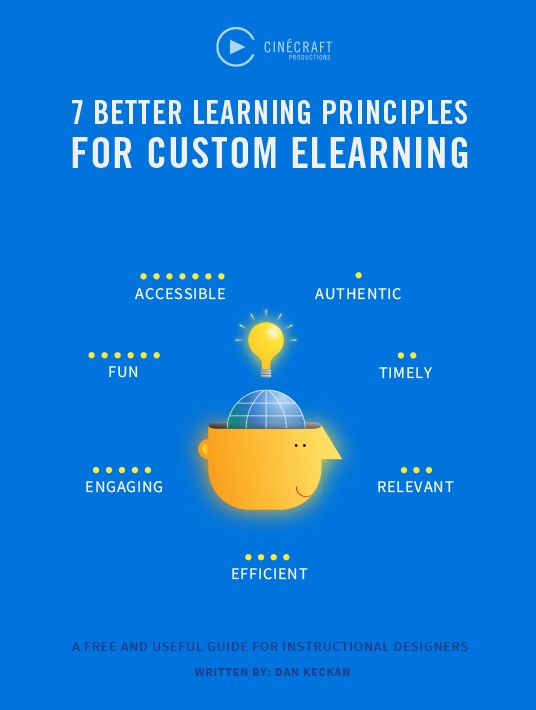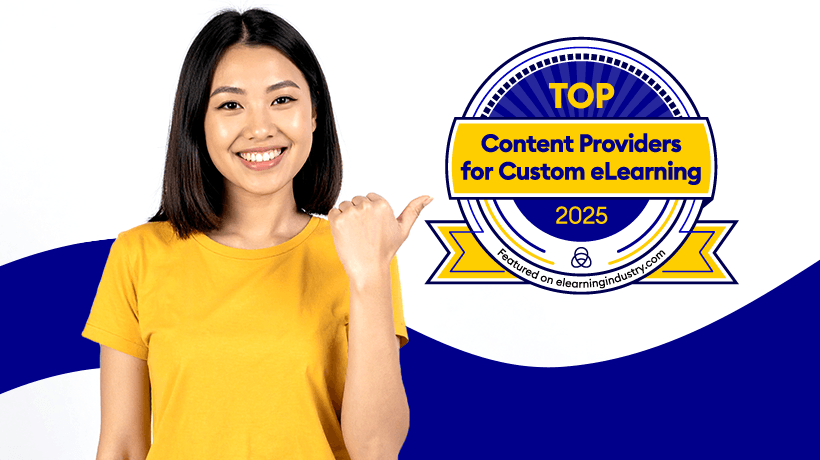Applying The 7 Better Learning Principles For Custom eLearning: Going For Long Term Results
The 7 "Principles" mentioned in this eBook, developed by Dan Keckan, are based on 20 years of designing and reviewing effective and, unfortunately, ineffective courses. Simultaneously, they are also based on other people’s research and experience. There is a lot of value in apprenticeship. Perhaps, it is an even better and more effective teaching technique than most other approaches.

About The eBook
The method draws on the hypothesis that a more knowledgeable person engages in a task with a more novice person by describing their own thoughts as they work on a task. Within the task, they provide modeling of practices, coaching, scaffolding, articulation, reflection, and, finally, exploration. Cognitive apprenticeship, as it is also called, is not always a cost-effective or timely solution. Let's say you worked in a company where you were tasked with training a team of six new employees that work three different shifts on two different machines. The math for timely or cost-effective training just doesn’t work—or is hard to apply in any case. For a more feasible, timely and steady approach you might want to look into the benefit of applying the 7 Better Learning Principles to custom eLearning courses. These principles have properties that are defined by their effectiveness in learning.
Here are the 7 Better Learning Principles and their key performance-focused attributes, as described in the eBook:
- Authentic
Design is genuine, real, life-like, accurate and offers an opportunity for reflection and exploration. - Timely
Convenient, made available at a favorable or useful time. - Relevant
Learning is closely connected to the business needs and learning objectives. - Efficient
Content is streamlined, well-organized and minimizes learners' effort. - Engaging
Create learning that activates learners’ curiosity rather than providing meaningless clicks. - Fun
Delivery is entertaining, amusing, and enjoyable. - Accessible
Content is easy to understand, without obstacles and is attainable.
I will follow up on each individual principle to highlight them, starting with "Authentic." For custom eLearning to be Authentic, both the content and the overall course design must be as close to real-life as possible. By using scenarios and simulations you allow learners to build skills through exercise while providing them a secure place to make errors. With this approach, you can easily implement Authenticity into all aspects of eLearning. You will have to start early on in this process to authentically design eLearning courses. You’ll need to do more analysis beforehand, researching your learners’ context and goals in detail, after which you can realistically present the content. Amongst other things, you will have to define what the learners need in a crystal clear fashion.
Once you have a comprehensive expectation of the learners' typical behaviors, the next step in designing Authentic custom eLearning is to understand how these tasks are done in the real world. For instance, you might visit a specific company to observe or interview current high performers on the job. What does “reality” consist of for them? Which behaviors do they feel most comfortable with and which are they absolutely not satisfied with? What behavior does the environment facilitate? Authentic, also, implies using real-world situations.
Then there is the "Timely" benefit included in this Instructional Design strategy. Each resource you develop is smaller or shorter, which can decrease development time and publishing time. Any new training needs can be addressed much more quickly than with traditional, hour-long eLearning courses. Any of these methods will bring training resources to employees when they need them—that’s the meaning of Timely.
Creating a "Relevant" custom eLearning solution comes down to identifying the business goal, writing learning objectives to support this goal, and analyzing your content and narrowing it down based on what the learners actually need to be able to do on-the-job.
There are more than a few reasons why simulations are amongst the most "Efficient" solution. They are short—but effective. In less than 10 minutes, an employee can complete a simulation, where there is action and feedback regarding their performance, and at a time which is convenient for the employee. There is direct access to specific content and the employee never has to sit through coaching techniques and strategies that they won’t remember anyway.
How do you captivate your learner by being engaging? One way to engage is to create an interactive, video-based eLearning course that provides an employee with opportunities to make decisions when connecting with colleagues in a real-world situation. This “choose your own adventure” approach will engage the employee in the experience and present emotive feedback for the specific employee, which will hopefully make an impression and help alter their behavior (if necessary).
The element of "Fun," which means turning a course into a learning game that captures the learners’ attention and provides intrinsic rewards for playing, almost by definition makes the process enjoyable and fun. It's how you can make a learner love the course. Use a leaderboard where learners can compete against each other, employ in-course scoring that allows learners to compete against themselves to achieve a personal best, and use badges and other items that must be collected to “unlock” further areas.
When you hear "Accessible," you probably think of screen reader compatibility and closed captions. And, to some extent that is correct. All courses should be Accessible to people with impaired vision, hearing, and motor skills. But, this final principle is more about an expansive definition of Accessible, which impacts all learners. It is about not failing to provide an experience that was easy to understand and easy to use. An Accessible eLearning course is one that all learners in the target audience can access anywhere, on any device, and without obstacles. The content is easy to understand and can be attained without difficulty.
In Retrospect
The eBook concludes with a methodology to measure the applied 7 Better Learning Principles, enabling you to decide whether your eLearning projects are, in fact, upholding these learning Principles. The author of the eBook makes the recommendation to start as soon as the business goals and learning objectives are established in order to align your strategy with the principles. Take these 7 Principles and apply them through the analysis phase of your project, but continue to score your project after storyboarding, prototype development and once your course is programmed. Whether you want to use the tool to help navigate tricky conversations with SMEs or stakeholders, so that you can build the business case for better learning or whether you want to balance SME expectations with budget limitations and accelerated timelines, there is a lot of value to be found here. It's the reason I would recommend downloading our eBook: "7 Better Learning Principles For Custom eLearning" to truly optimize your custom eLearning processes. You can also watch the supporting webinar "Maximize Learning Effectiveness Using The 7 Better Learning Principles" and unlock the full potential of performance-based learning.









